
Posts Tagged: grapevine
A Bug That's Not Wanted in the Vineyards
Back in July of 2016, a team of researchers affiliated with the University of California, Davis, wrote in the journal Phytopathology that the three-cornered alfalfa leaf hopper, Spissistilus festinus, transmits the virus that causes grapevine red blotch virus. UC Davis integrated pest...
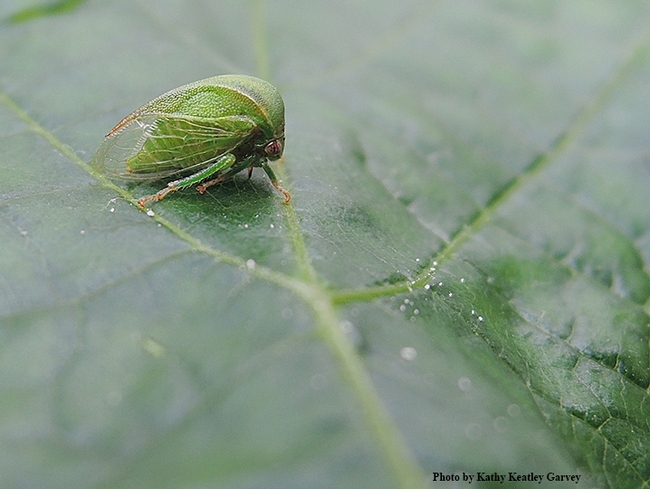
The three-cornered alfalfa leaf hopper, Spissistilus festinus, transmits the grapevine red blotch virus. (Photo by Kathy Keatley Garvey)
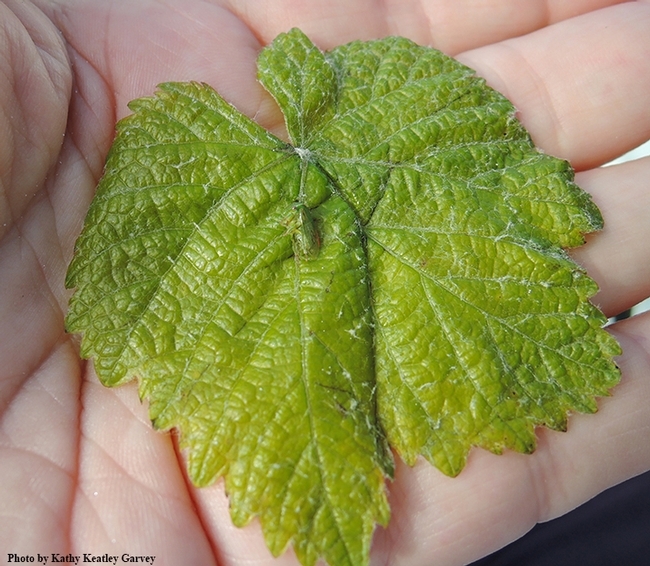
A three-cornered alfalfa leaf hopper, Spissistilus festinus, on a grape leaf. (Photo by Kathy Keatley Garvey)

The leaf on the right has grapevine red blotch virus. (Photo by Raul Girardelo, UC Davis)
Protecting American Coffee, Wine and Baseball Bats
"Protecting American Coffee, Wine and Baseball Bats Through Areawide Integrated Pest Management (AIPM)" Those catchy words headlined a recent notice of a congressional briefing. What does coffee, wine and baseball bats have to do with integrated pest management (IPM), you ask? Well, ...
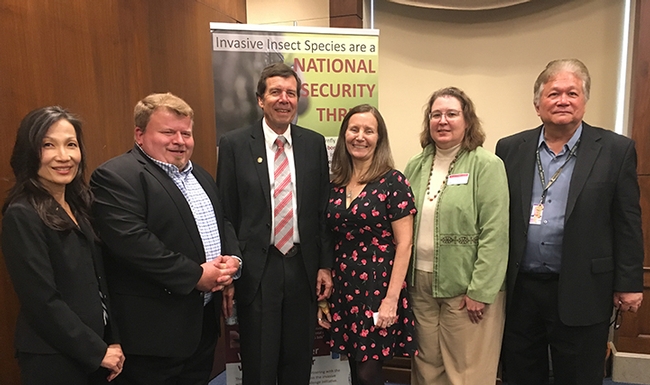
The panel gathers for a group photo following the congressional briefing. From left are Faith Oi, University of Florida; Lee Van Wychen, Weed Science Society of America; moderator Frank Zalom of UC Davis Department of Entomology and Nematology and a past president of the Entomological Society of America; Paula Shrewsbury of the University of Maryland; Kelley Tilmon of Ohio State University; and Dave Chun, chief of staff for Rep. Tulsi Gabbert. (Photo by Chris Stelzig)
Meet the Researchers and the Three-Cornered Alfalfa Hopper
UC Davis-based research involving the Grapevine Red Blotch Disease and the three-cornered alfalfa hopper, Spissistilus festinus, appears prominently in the news this week. It's the cover story of a special focus issue, "Disease Management in the Genomics Era," in the journal Phytopathology. The...
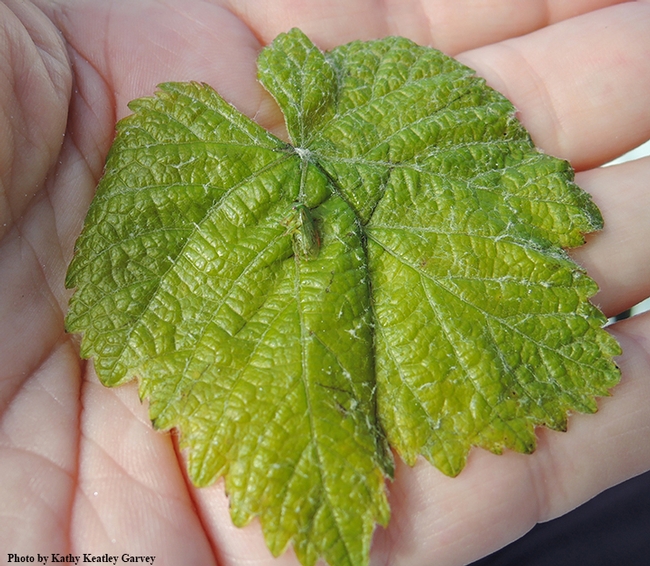
The tiny three-cornered alfalfa hopper on a grape leaf. (Photo by Kathy Keatley Garvey)
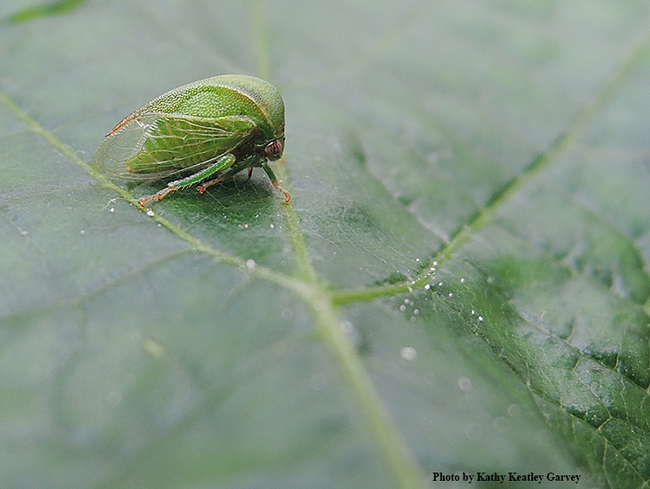
The three-cornered alfalfa hopper, Spissistilus festinus. (Photo by Kathy Keatley Garvey)
The European grapevine moth has officially been eradicated in California
The European grapevine moth, which was detected in Napa County in 2009 and threatened crops valued at $5.7 billion, has been eradicated from the state, reported Geoffrey Mohan in the Los Angeles Times.
The reporter gleaned information about and a photo of the moth from UC Agriculture and Natural Resources (UC ANR). The article credited ANR as explaining, "The moth's several larval stages damage flowers and the fruit itself throughout the growing season."
UC ANR played a key role in the eradicating the pest from California. A team of UC ANR academics received an award this year for coordinating a program "that saved the wine and table grape industries from economic disaster caused by an invasive insect," said the ANR Report.
ANR's European Grapevine Moth Team includes:
- Walter Bentley – UC Integrated Pest Management entomologist emeritus
- Larry Bettiga, UC Cooperative Extension advisor in Monterey County
- Monica Cooper, UC Cooperative Extension advisor in Napa County
- Kent Daane, UC Cooperative Extension specialist in the Department of Environmental Science, Policy and Management at UC Berkeley
- Rhonda Smith, UC Cooperative Extension advisor in Sonoma County
- Joyce Strand, IPM academic coordinator emeritus
- Robert Van Steenwyk, UC Cooperative Extension specialist in the Department of Environmental Science, Policy and Management at UC Berkeley
- Lucia Varela, UC Cooperative Extension area IPM advisor in the North Coast
- Frank Zalom, UC Cooperative Extension specialist and professor in the Department of Entomology at UC Davis
Sonoma County grape growers face a triple threat

“Invasive pests are a problem,” said Nick Frey, president of the Sonoma County Winegrape Commission. “They threaten California agriculture in general, and probably our ecology too, so it’s important to try to prevent their import into the state, and if they do get here, to detect them early. If you don’t get early detection, your odds of eradication are low.”
Rhonda Smith, UC Cooperative Extension advisor in Sonoma County, said local citizens also need to understand and comply with rules to prevent the introduction and spread of invasive species.
“The bottom line is, follow the rules,” Smith said, “because ultimately, the result is pretty dramatic. And who pays the price for that? We pay the price for the enormous effort to eradicate something once it’s here, and/or, we completely lose that industry. We then begin to eat more fruits and vegetables we don’t grow here in California.”
'Two-way learning' embraced
Tim Hearden, Capital Press
Rick Buchner, UC Cooperative Extension advisor in Tehama County, was featured as a "Western Innovator" in a Capital Press story published yesterday. In the article, he explained how the UCCE two-way learning model - involving UC academics and farmers - has been successful in solving agricultural problems.
"The beauty of extension is that we all learn together," Buchner said. "The growers know things that I don't, and I hopefully can share things from the university that they don't know. When we work together, it's a pretty powerful team."

